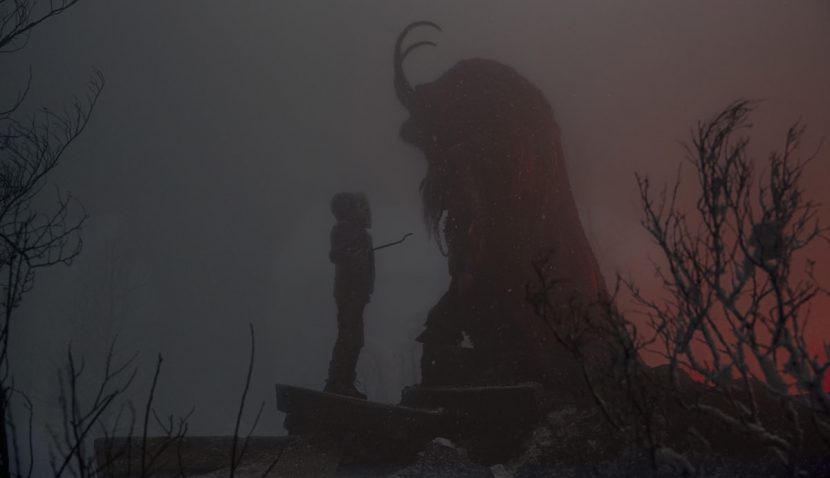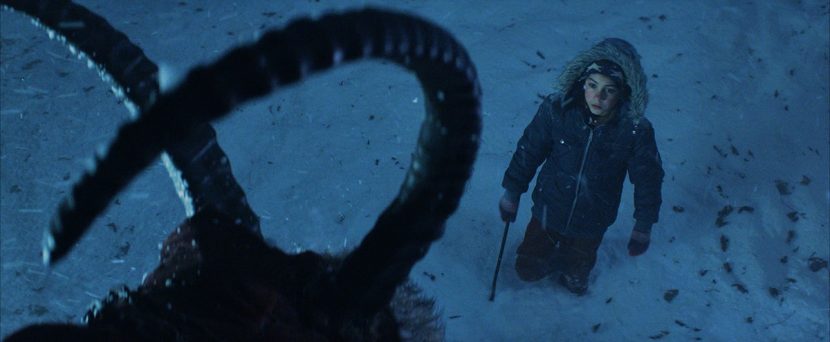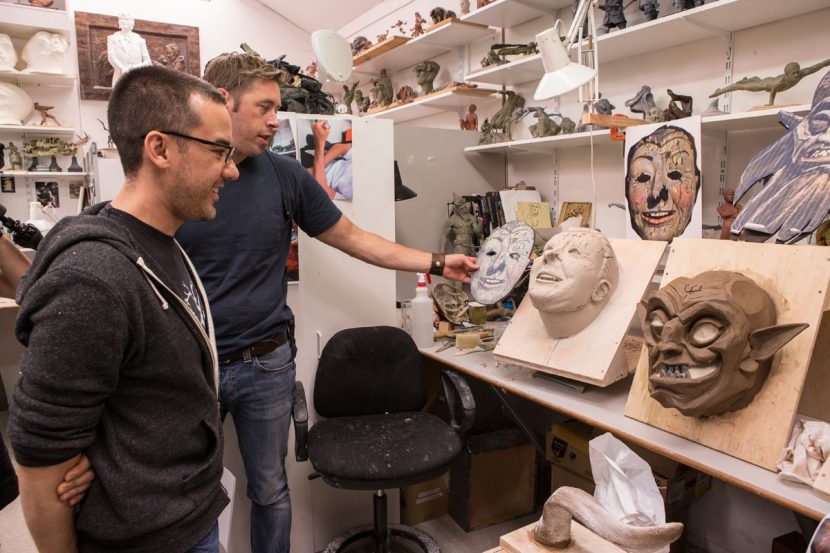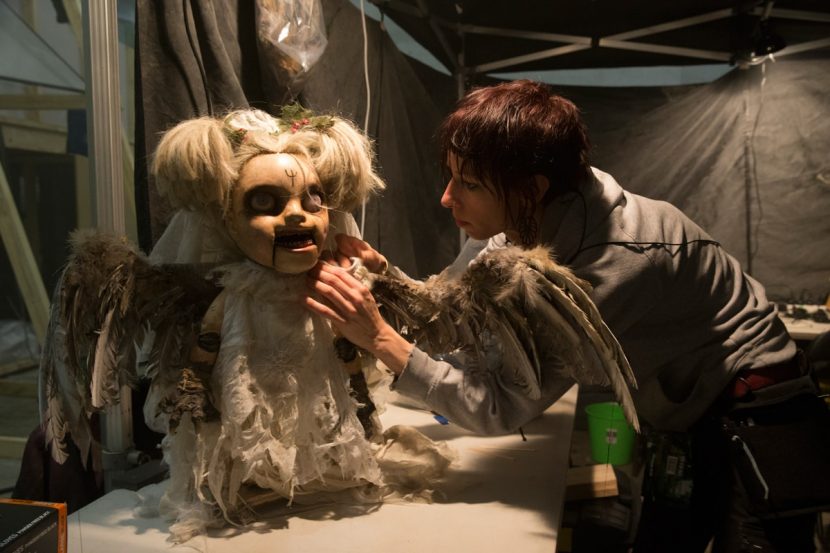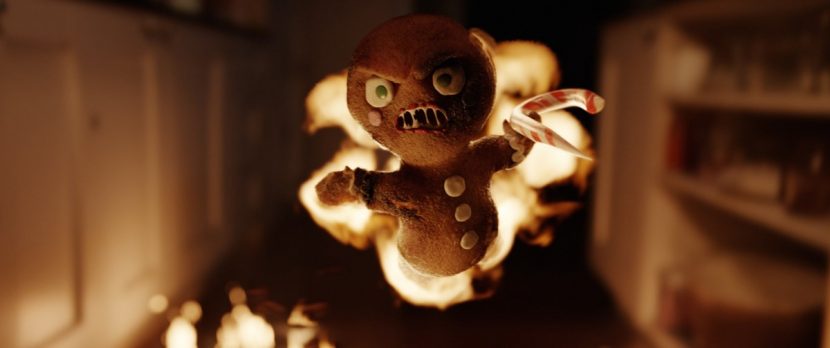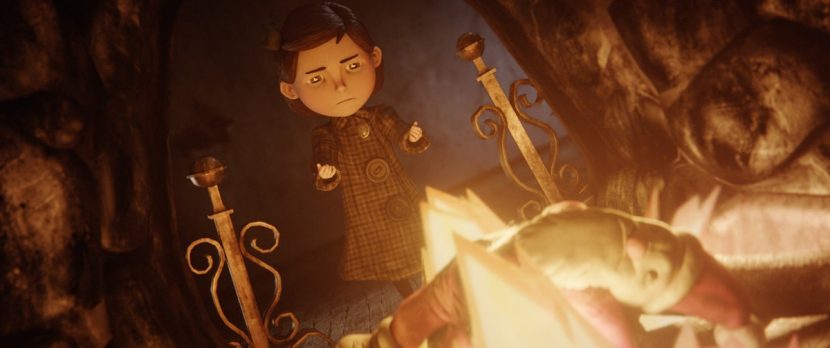Usually people celebrate the Christmas spirit, not get plagued by it. But in Krampus, the new horror comedy directed by Michael Dougherty, a suburban United States family finds itself tormented by an ancient demon spirit from Alpine folklore. Krampus’ powers enable the creature to summon a horrid array of Christmas toys and other beasts to terrorize the family.
In order to bring to life these strange encounters, Dougherty looked to utilize practical effects and real puppets as much as possible, enlisting Weta Workshop to craft the Krampus creature and his many minions. Weta Digital was also called upon to animate a group of mischievous Gingerbread men plus help extend the suburban environments. In addition, the digital studio delivered a three minute animated flashback piece for a crucial plot reveal.
Crafting the Krampus
Inheriting a wealth of concept art and designs from Dougherty’s art department, Weta Workshop built a Krampus costume that played to the ‘malicious intent’ within the character, which would be performed on-set by an actor. “We knew from the outset how we wanted to build it, which was basically a person in a suit played by Luke Hawker who is head of our model shop,” outlines Weta Workshop creative director Richard Taylor. “He’s also been in over 13 films as himself and as suit characters. So he’s our go-to guy because he’s working in the workshop every day but we can quickly throw him into the suit to test things and it gives him the wonderful qualities of being able to do what he loves doing while being a modelmaker.”
Artists crafted an under-structure for Krampus that matched the perceived anatomical muscles and bones of the creature and the distinctive horns on its head. “We built a fully-articulated skeleton that was worn over the top of the actor’s body, with huge shoulder extensions that lifted the shoulders well-above Luke’s head,” says Taylor. “Luke operated one of the hands which is extended beyond his own wrist in a creepy crawler way, which was servo-driven. And he operated the head à la Big Bird by putting his hand down the neck and the head is cantilevered out off a mechanism carried off his back into the front of the puppet.”
One of the biggest challenges for Krampus was the the actual material costume on top of the under-structure. “We had to keep it very, very light but it’s got to look extremely dense and thick and made up of many different layers and fabrics and chain,” explains Taylor. “All the decoration had to be molded and cast in very light material so that Luke would have a physical chance of moving it around. Flo Foxworthy sewed up the costume and it was an extraordinary complex piece with hundreds of individual panels sewn into it to give it the illusion of something that’s been historically gathered together over centuries.”
“We used store-bought fabric, velvet and velvetines,” says Foxworthy, “and then dyed them and then over-dyed them and distressed them to make them look worn and really soft, as though he’d been wearing this robe for centuries. Then the entire garment was individually patchworked together and hand-stitched and give it a real home made feel. It’s created to look as though he’s been adding to it over the years, with pieces of fabric from here and furs and skins from there. It was intertwined with a lot of lighter weight broken down silk fabrics that would float in the breeze to give the illusion of movement when he walked around, as though layers had been shredding off him. We wanted to keep a little bit of weight to the whole feel of the character, so having the heavier skins and furs around the edges helped to create a really beautiful drag.”
A final touch, and one of the last effects made by Weta Workshop, was Krampus’ sleigh. “It was a huge piece of construction – probably 15 feet long,” says Taylor. “It’s pulled by these weird humanoid goat-like characters that were done as people in suits and played by people in our workshop, among others. It was fun to do that at the end of the show. It gave all the modelmakers and usual miniature builders in construction an opportunity to be involved.”
Not so cuddly teddy bear
Weta Workshop puppeteers rehearse with the teddy bear.
The family is besieged by several of the Krampus’ associates, among them a rabid teddy bear. “It was our favorite character,” notes Taylor. “The teddy is very endearing in many ways – we found him to be a lovely character. I think he might have a soft spot in people’s minds when they see the movie. It was a simple hand-operated puppet but like all things it’s that on-going challenge of trying to rub your tummy and pat your head at the same time. That’s difficult enough for one person, trying to do with three people puppeteering a single puppet requires a lot of careful rehearsals. Our puppeteers went through a lot of practice to ultimately garner what they were able to do in the show.”
“We pre-rehearse and pre-shoot everything before we get on set with the director,” adds Taylor. “In this case, Rob Gillies, our workshop supervisor, took up the task. He opted to be the pre-director and directed all our sequences with our puppeteers. If you don’t get people into character, they’re not going to be as if they are a teddy bear. You do have to get into this psychological place and be a nasty character. Our team will actually literally vocalize and verbalize the character as they perform it to try and give over the best qualities of the character. If you don’t do that, if you get a half-baked endeavor, it never comes through. There can’t be too many jobs better than performing a maniacal teddy bear that bites throats, hey?”
Practical plus
In addition to the Krampus and teddy bear, Weta Workshop produced a plethora of other practical creatures, many being the Krampus’ minions. “It’s basically a bunch of Christmas toys come alive,” recounts Taylor. “There’s an articulated clockwork robot that a child might get for Christmas. It gets the spirit of Krampus in it and runs amok. It switches out its gripper hands for these horrible scissors.”
Do you want to build a snowman?
“The snowmen were carved in polystyrene,” outlines sculptor Javier Murcia. “We carved the shapes and then put a lot of shadows and stick some kind of paper, the kind you use to bake things in the oven, or even thinner. You stick that on the surface and you could see the shadow underneath coming through it. Then you put fake snow on top of that. The final result is amazing because it looks so real.”
“One of the creepiest characters we were asked to do was this wonderful Jack in the Box,” continues Taylor. “Out of this little tiny box pops this psychotic clown still attached to the box, and it has the ability to split its mouth open and consume naughty children – which is fantastic! It’s a fun thing to achieve in a construction such as that.”
Other creations included Gingerbread men (also completed as digital characters by Weta Digital – see below), snowmen (see sidebar), a crazed nutcracker and dark elf masks. “These masks were worn by little people and were really fabulous characters to develop,” states Taylor. “They’ve got wooden carved masks on in the style of the Austrian Christmas mask but these are slightly more crazy maniacal versions of it. And then there’s this cherub on the top of the Christmas tree. We built it as an overscale puppet made as if it was out of cracked porcelain. That was a very beautiful puppet with very complex layers of lace clothing and horrible claw hands.”
You can’t catch the Gingerbread men
Krampus also employs his Gingerbread men minions to torment the family. Although practical versions were present on set, the characters were mostly realized via digital effects by Weta Digital. In a showcase scene, several Gingerbread men attack Howard (David Koechner) in the kitchen using a nail gun. “Howard is there with a shotgun and he’s heard a noise and is trying to see what’s going on,” explains Weta Digital visual effects supervisor Kevin Smith. “They’ve found a nail gun and they attack him and shoot him in the leg. The brief was that they’re laughing and giggling and carrying on with the nail gun like the little assholes they are.”
On set, a practical Gingerbread man had been used for an early chimney sequence and so stood in for the CG creatures. “We drilled a couple of holes in the bottom and put him on a stand,” says Smith. “We could use that for lighting reference when we shot HDRIs. And for the actor in the kitchen it helped with eyelines.”
Weta Digital approached the animation of the Gingerbread men by taking advantage of the characters’ limited dimensions. “You’ve got a cookie, basically,” admits Smith. “They’ve got short stubby arms and legs and a giant head. There’s very little room to do really expressive body motions. You can’t squash and stretch too much. The hardest thing was balancing the sub-surface with the amount of detail on the surface and the displacement. There was a very line between looking like a rock and looking too mushy.”
“They were almost like The Three Stooges,” adds animation supervisor Dave Clayton. “They’re always at each other, but they work as a team to try and horrify the main character, Howard. What’s interesting was that they don’t have any fingers or toes so they were easy to animate. We were able to get in there and try stuff out. They were very forgiving which meant you could just put their arms to their sides not doing anything, because that’s sort of funny – they don’t have a lot of range of motion. When they run they just scurry along without much articulation.”
Clayton also found that the animators could achieve mischievous and nasty behaviors quite easily with simple face shapes. “We made sure they had a really good maniacal expressions, gnarly expression, and shocked expression,” he says. “We could animate between those states in almost a stop motion way. When they blink their eyelids just pop on and pop off. That was done on purpose to make it feel like, maybe they were stop motion animated?”
At one point the Gingerbread men run out of bullets, allowing Howard to use his shotgun to take out a lantern on the countertop. He thinks he’s blown the creatures out of existence after an explosion, but the Gingerbread men – now on fire – continue their attack. “For those shots,” recalls Clayton, “we took time to set up simple cards with fire textures cycling on those which we could constrain to different body parts to get an idea of how much they’re on fire. They are trying to put themselves out and chase the uncle again. The fattest gingerbread man, only his head is on fire whereas the other guys are almost completely engulfed in flames. We used Gazebo to see how these played, which is our custom viewport renderer – even our animation submissions looked pretty sophisticated.”
Flashing back
In a breakout animated flashback created by Weta Digital, the grandmother Omi (Krista Stadler) admits that she has previously encountered the Krampus as a child. “It’s very stylized and feels stop motion-y,” describes Smith. “The filmmakers wanted it to feel like it had been done by this 85 year old Eastern European animator in their basement for six months. We kept it very simple. We had a fully realized Omi puppet in 3D but the other characters were kept as silhouettes.”
Artists worked up an animatic to match Omi’s narration, then broke the piece down into individual shots. “We didn’t want to make it perfect – we had to embrace the imperfections,” notes Clayton. “It had to feel like it was animated with an artist’s hands. We had extra textures on Omi’s clothes to make it feel like it was getting bumped around, for instance. Initially we were animating on 5s to get that real stop motion look, but after we saw some of the lighting and comp treatment, we realized we could make it feel really tactile and it had been filmed on a miniature set with a shallow depth of field. So we opened up the brief of animation to make it on 1s and created imperfections with the cloth jerking and her movements were more snappy.”
“We did some environments too,” adds Smith, “but our concept artist simply did some art and we basically cut that out and put it on cards, almost like it was an animation plane. My brief to the artists was, think of it as if you were really doing it. If there’s a fireplace, I’d say, don’t use CG fire – how would you do it in stop motion? – perhaps use tissue paper with a little 40 watt bulb behind it. Whenever we added snow, we roto’d out little shapes as if someone sat down with an Oxberry animation stand and made snowflakes a frame at a time and comp’d them over the top. It really helped tell the story of Krampus coming to see Omi at Christmas and killed her family. Hey, it is a horror movie!”
Extending the world
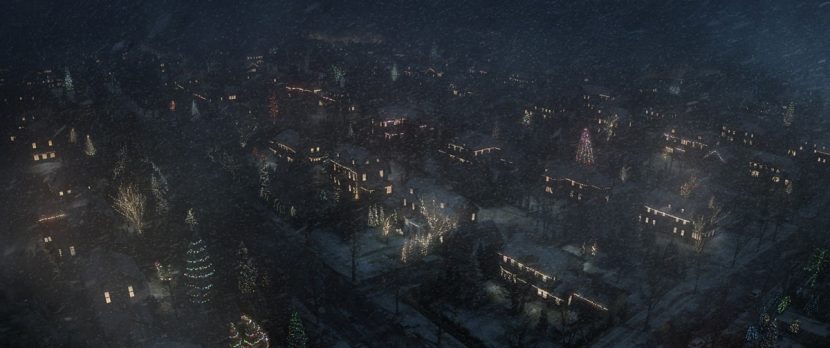 Krampus was shot mostly at Stone Street Studios in Wellington on sound stages. Weta Digital helped broaden the scope of the film by adding streetscapes and extending some third scale house sets. “We used the street and snow that was in the plates, and the first 20 feet of the yards and some practical trees,” explains Smith, “and then we cleared all the atmosphere out and shot it all against green, and did digital matte paintings as the characters ran down the street. We had to shoot the greenscreens unlit because we did use some falling snow and atmosphere. If we had lit them the entire set was white and would contaminate everything. If you look closely you can see some distinctive houses the director wanted in there from the Amityville Horror, Jason’s house from Halloween, the Ferris Bueller’s house.”
Krampus was shot mostly at Stone Street Studios in Wellington on sound stages. Weta Digital helped broaden the scope of the film by adding streetscapes and extending some third scale house sets. “We used the street and snow that was in the plates, and the first 20 feet of the yards and some practical trees,” explains Smith, “and then we cleared all the atmosphere out and shot it all against green, and did digital matte paintings as the characters ran down the street. We had to shoot the greenscreens unlit because we did use some falling snow and atmosphere. If we had lit them the entire set was white and would contaminate everything. If you look closely you can see some distinctive houses the director wanted in there from the Amityville Horror, Jason’s house from Halloween, the Ferris Bueller’s house.”
For an exterior scene, too, Weta Digital delivered a CG Krampus that ran along some rooftops. “There is a sequence where the daughter goes outside into a storm and you get a look at him and he’s up on the rooftops as the character walks down the street,” says Smith. “He follows along jumping from rooftop to rooftop. So that was a digital Krampus. We scanned and photographed the heck out of the Workshop creation, but it didn’t have to be super high quality. They also didn’t want to give it away yet. It’s not the hero reveal of the character.”
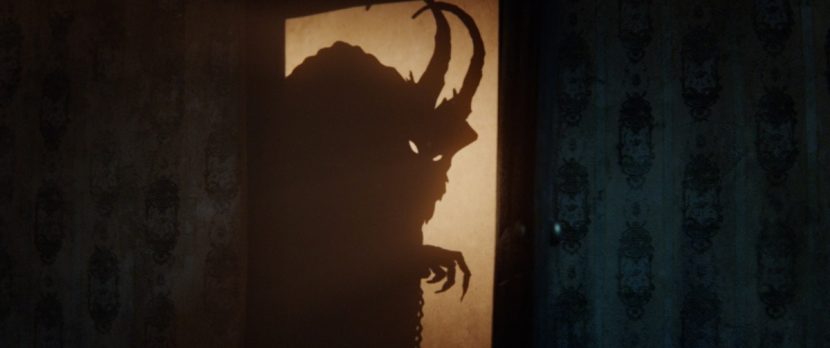
“For those shots,” adds Clayton, “we had a pretty simple puppet representation of him – he’s really defined by this classic cloak. It was tricky to animate this underlying character but we had to make sure sims matched the movement of the live action. We had a cool sketch of what Krampus looked like underneath the robes – that meant we could do what was underneath – cloven hooves and goat legs – and that affected the way he jumped from the rooftops.”
Perhaps best evidencing the director’s desire for a practical aesthetic to the film, Weta Digital was called upon to create the Krampus’ menacing tongue when he confronts Omi for the second time – with strict instructions that it look hand-made. “It had to be horrifying,” says Clayton, “but Michael kept directing us to more of a tongue effect that looked like it could have shot on set, referencing Jabba the Hutt for example. It was fun to get the tone right for that.”
Images copyright: TM & © 2015 Legendary. All rights reserved.

